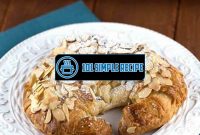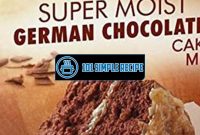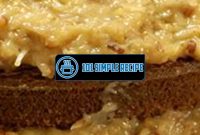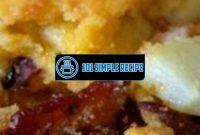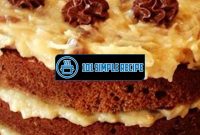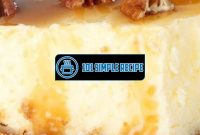Welcome to the world of German baking! In this article, you will discover the secret to baking the perfect German cake. Germany is renowned for its culinary traditions, and their cakes are no exception. Whether it’s the rich and indulgent Black Forest cake or the light and delicate Baumkuchen, German cakes are loved by people worldwide. So, what makes these cakes so special? How can you recreate that authentic German taste in your own kitchen? Get ready to unlock the tips and tricks that will elevate your baking skills to new heights. But first, let’s take a moment to appreciate the mouthwatering beauty of a freshly baked German cake. Feast your eyes on the image below.
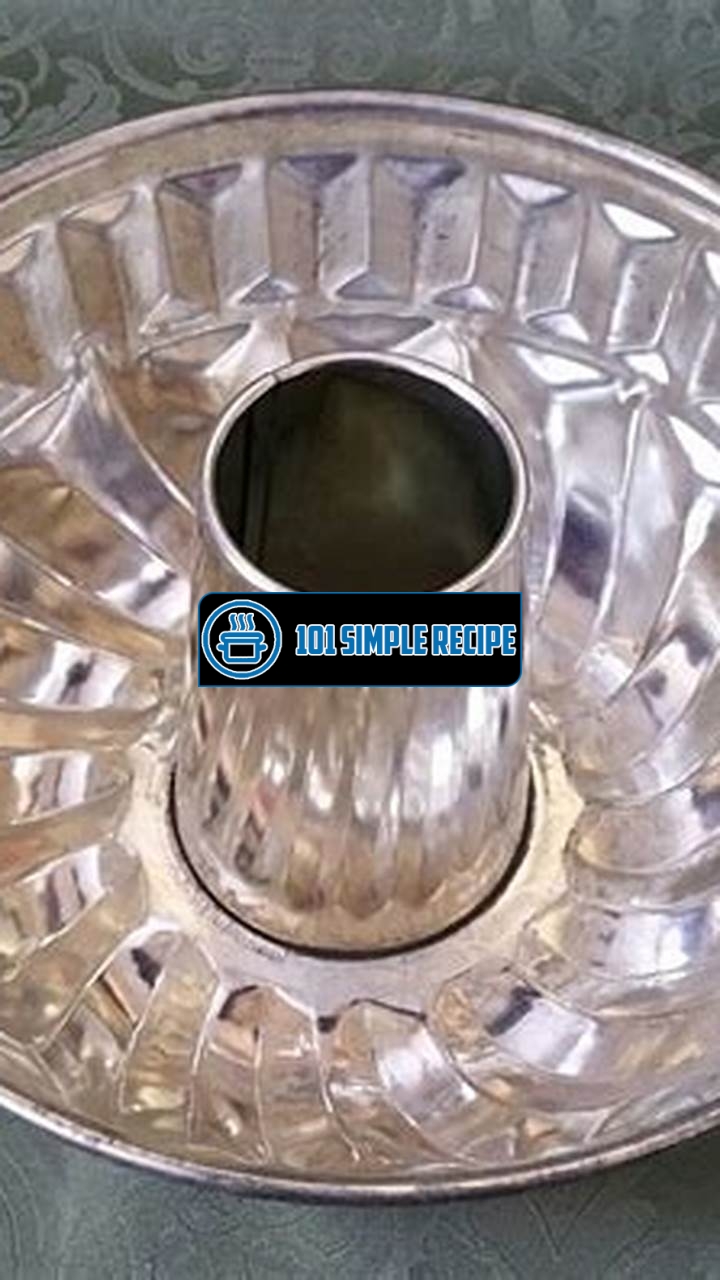
Understanding German Cake Pans
German cake pans are an essential tool for any baking enthusiast looking to create the perfect German cake. These specialized pans are designed to enhance your baking experience and help you achieve delicious and authentic results.
German cake pans have a rich history and come in a variety of types, sizes, and materials. Understanding their significance and choosing the right one for your baking needs is crucial to ensure your cakes turn out just right.
The History of German Cake Pans
The roots of German cake pans can be traced back to the 18th century when baking became a popular pastime in Germany. As baking traditions evolved, so did the need for specialized pans that could withstand high temperatures and produce unique cake shapes.
Cake pans were initially made from cast iron or clay, which allowed for even heat distribution and retention. These pans were often intricately designed, featuring detailed patterns that would be imprinted onto the cake’s surface.
Over time, advancements in technology led to the production of cake pans made from materials such as tin, aluminum, and stainless steel. These pans offered greater durability and versatility, allowing bakers to experiment with different cake designs and sizes.
Types of German Cake Pans
German cake pans come in various types, each serving a unique purpose in creating specific cake styles. Some common types include:
- Bundt Pans: These pans have a circular shape and a hollow center, resulting in cakes with a distinctive ring shape. Bundt cakes are often decorated with glazes and garnishes to enhance their visual appeal.
- Springform Pans: Springform pans feature a removable bottom and sides that are secured with a latch. This allows for easy removal and presentation of delicate cakes like the traditional German cheesecake.
- Sheet Pans: Sheet pans are large, flat baking pans used for making sheet cakes. These cakes are often layered and decorated, making them ideal for special occasions.
- Heart-Shaped Pans: Heart-shaped pans are commonly used for baking cakes for romantic occasions such as Valentine’s Day or anniversaries. They add a touch of love and nostalgia to your baked creations.
Choosing the right type of German cake pan depends on the specific cake you want to bake. Consider the design, size, and shape you desire to achieve bakery-worthy results.
Choosing the Right Size and Material
When it comes to German cake pans, size and material are crucial factors to consider.
Selecting the right size depends on the desired number of servings and the recipe you are using. It is essential to ensure that your chosen pan can accommodate the entire cake batter comfortably, allowing it to rise evenly during baking.
✨ Additionally, the material of the cake pan can significantly impact the baking process. Different materials have varying heat conduction properties, affecting how your cake bakes and browns. Aluminum pans, for example, distribute heat more evenly, resulting in uniformly baked cakes.
Remember to refer to the recipe instructions or a baking guide to determine the recommended pan size and material for the German cake you wish to make. This will help you achieve optimal results and avoid potential baking mishaps.
In conclusion, German cake pans are more than just baking tools; they are a gateway to creating authentic and delicious German cakes. By understanding the history, types, and choosing the right size and material, you can elevate your baking skills and enjoy the delightful world of German cake making. So, grab your German cake pan, preheat the oven, and get ready to bake a truly delectable treat!
Baking with German Cake Pans
Are you ready to elevate your cake baking game? Look no further than German cake pans. These specialty pans are designed to help you achieve delicious and professional-looking cakes that will impress your family and friends. In this article, we will explore the tips and techniques for using German cake pans to create mouthwatering treats.
Prepping Your German Cake Pan
Before you start baking, it’s important to properly prepare your German cake pan. This will ensure that your cake comes out effortlessly and in perfect shape. Begin by greasing the pan generously with butter or non-stick cooking spray. This will prevent the cake from sticking to the pan and allow for easy release.
If your German cake pan has removable sides or bottoms, make sure they are securely in place before pouring the batter. This will create cleaner edges and make it easier to remove the cake once it’s done baking. Additionally, you can line the bottom of the pan with parchment paper for extra insurance against sticking.
Note: Properly prepping your German cake pan is essential for achieving a flawless cake. Take your time and pay attention to detail to ensure the best results.
Understanding Baking Times and Temperatures
Baking times and temperatures can vary depending on the recipe and the size of your German cake pan. It’s important to follow the instructions provided with your recipe, but here are some general guidelines to keep in mind.
German cake pans are known for their intricate designs and shapes, which can sometimes affect the overall cooking time. It’s advisable to start checking the cake for doneness a few minutes before the recommended baking time. This will prevent overcooking and ensure a moist and tender cake.
When it comes to temperature, most German cake recipes call for a moderate oven temperature, usually around 350°F (180°C). However, always refer to your specific recipe for accurate temperature instructions.
Note: Keep a close eye on your cake while it’s baking to prevent under or overcooking. Every oven is different, so adjust the baking time and temperature as needed.
Decorating Tips for German-style Cakes
German-style cakes are known for their beautiful decorations that can turn any ordinary cake into a work of art. Here are some tips to help you achieve stunning results:
- Use a piping bag: Invest in a good piping bag and experiment with different tips to create intricate designs and patterns on your cake.
- Try different fillings: German-style cakes often feature delicious fillings such as fruit preserves, chocolate ganache, or pastry cream. Get creative and experiment with different flavors.
- Add a touch of elegance with powdered sugar: Dusting your cake with powdered sugar can instantly elevate its appearance. Use stencils or create your own designs to add a personal touch.
Note: Experiment with different decorating techniques to find your unique style. Have fun and let your creativity shine!
By following these tips and techniques, you’ll be well on your way to baking the perfect German cake using German cake pans. Remember to properly prep your pan, keep an eye on baking times and temperatures, and let your creativity soar when it comes to decorating. Happy baking!
White Castle recipe offers a delicious burger that can be enjoyed with a slice of German cake. The combination of savory and sweet flavors is a perfect match.
Advantages of German Cake Pans
When it comes to baking the perfect German cake, using a German cake pan is essential. These pans have become a favorite among bakers for their unique benefits and exceptional quality. In this article, we will explore the advantages of German cake pans and why they are a must-have for any baker.
Even Heat Distribution for Perfectly Baked Cakes
One of the key advantages of German cake pans is their ability to provide even heat distribution, resulting in perfectly baked cakes. These pans are typically made from high-quality materials such as aluminum or stainless steel, which ensures that heat is distributed evenly throughout the pan.
- The even heat distribution of German cake pans guarantees that your cakes will bake evenly, with no hot spots or undercooked areas.
- This uniform heat distribution also helps in achieving a beautiful golden-brown crust on the outside while keeping the inside moist and fluffy.
- ⏳ Say goodbye to overcooked edges and undercooked centers with German cake pans’ ability to provide consistent and reliable results every time.
Durable and Long-lasting Quality
German cake pans are known for their exceptional durability and long-lasting quality. These pans are designed to withstand high temperatures and frequent use, making them a reliable choice for professional bakers and baking enthusiasts alike.
- Made from sturdy materials, such as heavy-gauge steel or cast iron, German cake pans are built to last for years, even with regular use.
- Their durable construction ensures that the pans won’t warp, bend, or corrode, providing you with a reliable baking tool that will stand the test of time.
- Whether you’re a professional baker or a home cook, investing in a German cake pan guarantees that you’ll have a reliable and durable tool in your kitchen for all your baking needs.
Versatile and Multipurpose for Various Baking Recipes
German cake pans are not only perfect for baking traditional German cakes but also versatile enough to be used for various other baking recipes. These pans come in different shapes and sizes, allowing you to easily adapt them to suit your baking needs.
- German cake pans are great for baking cookies, muffins, brownies, and other delicious treats. Their non-stick surface ensures easy release and effortless cleanup.
- With their deep sides and sturdy construction, German cake pans are also ideal for making cheesecakes, quiches, and other savory baked dishes.
- You can even use these pans for making bread and other yeasted doughs, thanks to their superior heat distribution and non-stick properties.
From sweet to savory, German cake pans have you covered for all your baking adventures.
Final Thoughts: German cake pans are the secret to baking the perfect German cake. Their even heat distribution, durable quality, and versatility make them a favorite among bakers. Invest in a German cake pan today and elevate your baking game to new heights!
Caring for Your German Cake Pan
Discover the essential maintenance and cleaning tips to prolong the lifespan of your German cake pan.
Proper Storing and Handling
Properly storing and handling your German cake pan is crucial to ensure its longevity. Follow these tips:
- Store in a cool, dry place: After each use, make sure the pan is completely dry before storing it. Moisture can lead to rust and damage. Find a cool and dry place in your kitchen cabinets or pantry to keep it safe.
- Avoid stacking: If you have multiple German cake pans, avoid stacking them on top of each other. This can cause scratches and dents, affecting their performance. Instead, store them individually or use dividers to separate them.
- Protect the non-stick coating: If your German cake pan has a non-stick coating, take extra care to protect it. Avoid using metal utensils that can scratch the surface. Opt for silicone or wooden utensils instead.
- Use a protective cover: Consider using a protective cover or sleeve specifically designed for cake pans. This can provide an extra layer of protection against scratches and dust.
Cleaning Techniques for German Cake Pans
Proper cleaning is essential to maintain the performance and hygienic quality of your German cake pan. Follow these techniques:
- Gentle hand washing: Avoid using harsh chemicals or abrasive scrubbers, as they can damage the surface of your cake pan. Instead, hand wash it using warm water, mild dish soap, and a soft sponge or cloth. Rinse thoroughly and dry immediately with a towel.
- Remove stubborn stains: If you encounter stubborn stains or residue, create a paste using baking soda and water. Apply the paste to the affected area and let it sit for a few minutes before gently scrubbing and rinsing.
- Avoid dishwasher use: While some German cake pans claim to be dishwasher-safe, it is generally recommended to hand wash them. The high heat and harsh detergents in dishwashers can potentially damage the non-stick coating or warp the pan.
Common Mistakes to Avoid
By knowing the common mistakes to avoid, you can prevent potential damage and ensure the longevity of your German cake pan:
- Using metal utensils: Metal utensils can scratch the non-stick coating or even cause dents in the pan. Stick to silicone, wooden, or plastic utensils to protect your cake pan.
- Skipping the seasoning process: Some German cake pans require a seasoning process before the first use. Follow the manufacturer’s instructions to properly season your pan and create a protective coating.
- Using excessive heat: Avoid using high heat settings when baking with your German cake pan. Excessive heat can damage the non-stick coating and affect the overall performance.
- Neglecting proper storage: Improper storage can lead to scratches, dents, and rust. Store your German cake pan in a cool, dry place and avoid stacking them on top of each other.
- Using abrasive cleaning tools: Stay away from abrasive scrubbers, steel wool, or harsh chemicals when cleaning your cake pan. Opt for soft sponges or cloths and mild dish soap for gentle yet effective cleaning.
Take good care of your German cake pan, and it will reward you with many delicious cakes for years to come!
German cake pan is an important tool for baking traditional German cakes. It ensures that the cakes are baked evenly and achieve the desired shape.
Exploring German Cake Pan Recipes
Get ready to embark on a culinary adventure through Germany with these delightful cake recipes that can be made using your German cake pan. Whether you are a baking enthusiast or simply enjoy indulging in homemade treats, these recipes are sure to satisfy your sweet tooth. So, let’s dive right in and discover the secret to baking the perfect German cake!
Classic Black Forest Cake
One of the most famous German cakes, the Classic Black Forest Cake is a true indulgence. Picture this: layers of rich chocolate cake, generously filled with cherries and fresh whipped cream. This decadent dessert is guaranteed to leave your taste buds dancing with delight. Using your German cake pan, you can easily create this masterpiece of a cake that will impress all your family and friends.
To make the Classic Black Forest Cake, start by baking two moist chocolate cake layers in your German cake pan. Once they have cooled, carefully remove them from the pan and place one layer on your serving plate. Spread a layer of cherry filling over the cake, followed by a generous amount of whipped cream. Repeat this process with the second cake layer, topping it off with more cherries and whipped cream. To add a finishing touch, sprinkle some chocolate shavings on top.
Authentic Bee Sting Cake (Bienenstich)
Next on our journey through German cake recipes is the Authentic Bee Sting Cake, also known as Bienenstich. This unique cake gets its name from the caramelized almond topping that resembles a bee’s sting. The combination of creamy vanilla pastry cream and the crunchy almond layer creates a delightful contrast of flavors and textures.
To create the Authentic Bee Sting Cake, start by making a yeast-based dough and pressing it into your German cake pan. Allow the dough to rise until it doubles in size, then bake it until golden brown. While the cake is baking, prepare a creamy vanilla pastry cream to fill the cake. Once the cake has cooled, slice it in half horizontally and spread the pastry cream in the middle. Finally, top the cake with the caramelized almond layer, creating a visual and tasty treat.
German Apple Streusel Cake
Last but definitely not least, we have the mouthwatering German Apple Streusel Cake. This cake celebrates the flavors of juicy apples combined with a buttery and crumbly streusel topping. It is the ultimate comfort food and a perfect treat for any occasion.
Using your German cake pan, start by preparing a simple batter infused with the flavors of cinnamon and nutmeg. Pour the batter into the pan and top it generously with sliced apples. Finish the cake off with a streusel mix made with flour, butter, sugar, and a pinch of salt. As the cake bakes, the apples soften and release their juices, creating a delightful filling. The streusel topping adds a lovely crunch and sweetness, making this cake hard to resist.
Now that you have explored a variety of German cake recipes made using your German cake pan, it’s time to roll up your sleeves and start baking. Whether you choose the rich and indulgent Black Forest Cake, the unique Bee Sting Cake, or the comforting Apple Streusel Cake, you are sure to be transported to the charming bakeries of Germany with every bite. So preheat your oven, gather your ingredients, and let the baking festivities begin!
Weight loss recipe can be paired with a slice of German cake in moderation, allowing you to indulge without compromising your health goals.
Frequently Asked Questions
Thank you for taking the time to read our article about German cake pans. We hope you found it informative and helpful for your baking endeavors. Below are some frequently asked questions:
| No. | Questions | Answers |
|---|---|---|
| 1. | What is a German cake pan? | A German cake pan is a special type of baking pan traditionally used for making German cakes, such as Black Forest cake or German apple cake. It typically has a round shape with a removable bottom, making it easy to release the cake after baking. |
| 2. | Where can I buy a German cake pan? | German cake pans can be found in specialty kitchen stores, online retailers, or even in some larger department stores. It is recommended to check for customer reviews and ratings before making a purchase. |
| 3. | Can I use a regular cake pan instead? | While you can use a regular cake pan as a substitute, a German cake pan is specifically designed to enhance the baking process for German-style cakes. The removable bottom and shape of the pan help create the ideal texture and presentation of the cake. |
| 4. | How do I care for a German cake pan? | To care for your German cake pan, make sure to wash it with warm, soapy water after each use and dry it thoroughly. Avoid using abrasive cleaners or utensils that could scratch the surface. Additionally, it is recommended to grease the pan before each use to prevent sticking. |
| 5. | What are some popular German cake recipes? | Some popular German cake recipes include Black Forest cake, German apple cake, Sachertorte, and Bee Sting cake. These cakes showcase the rich flavors and techniques of German baking. |
| 6. | Are German cake pans only used for sweet cakes? | No, German cake pans can also be used for savory dishes, such as quiches or tarts. The versatility of the pan allows for a wide range of culinary creations. |
Thank You for Reading!
We hope you enjoyed learning about German cake pans and their significance in German baking traditions. If you have any more questions or would like to explore more baking topics, feel free to visit our website again in the future. Happy baking!
Jump to Recipe
German Cake Pan

Learn all about German cake pans and their importance in German baking traditions. Find answers to common questions and get inspired to create delicious German cakes!
- 2 cups all-purpose flour
- 1 cup sugar
- 1/2 cup unsalted butter (softened)
- 3 eggs
- 1 teaspoon vanilla extract
- 1 teaspoon baking powder
- 1/2 teaspoon salt
- 1 cup milk
- Preheat the oven to 350°F (175°C). Grease the German cake pan with butter or cooking spray.
- In a mixing bowl, cream together the softened butter and sugar until light and fluffy.
- Add the eggs one at a time, beating well after each addition. Stir in the vanilla extract.
- In a separate bowl, whisk together the flour, baking powder, and salt. Gradually add the dry mixture to the wet mixture, alternating with milk.
- Pour the batter into the greased German cake pan and spread it evenly.
- Bake for 45-50 minutes or until a toothpick inserted into the center comes out clean.
- Allow the cake to cool in the pan for 10 minutes before transferring it to a wire rack to cool completely.

